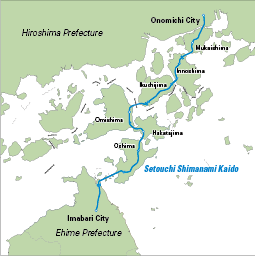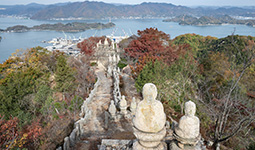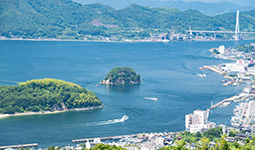April 2023
- English
- 日本語
Cycling Over the Sea: The Setouchi Shimanami Kaido

The Shimanami Kaido cycle and pedestrian path runs alongside the expressway on the bridges 
The Kurushima Kaikyo Bridge comprising three successive suspension bridges, part of the Shimanami Kaido

Map of the Setouchi Shimanami Kaido 
Lemons growing on Ikuchijima Island, also known as Lemon Island 
View over Buddhist statues from Shiratakiyama mountain, Innoshima Island 
View from Innoshima Park, Innoshima Island

The Setouchi Shimanami Kaido* is the first route over sea straits that can be traveled by bicycle in Japan. It is a popular place for fun cycling while taking in stunning views of the islands in the Seto Inland Sea.

The Setouchi Shimanami Kaido is an expressway connecting Japan’s main islands of Honshu and Shikoku by a series of bridges and crossing six small islands in the Seto Inland Sea. The road, which opened in May 1999, runs between Onomichi City in Hiroshima Prefecture and Imabari City in Ehime Prefecture, and is open to pedestrians and cyclists on the bridge sections where a designated path runs parallel to the expressway. The cycle route uses local roads on the islands, away from the expressway, and is about 70 kilometers long. It has been awarded a one star rating in the Michelin Green Guide Japan and was named by America’s CNN travel website as one of the “Seven Best Bike Routes in the World.” It has become a popular destination for cyclists from across the globe.
From the bridges along the route, cyclists can enjoy a panoramic vista of the Seto Inland Sea dotted with islands large and small. Zipping through the sea breeze high above the water while enjoying picturesque blue sky and sea, verdant islands, and colorful bridges is the great attraction of cycling along the Shimanami Kaido.

Along the way, cyclists can rest their legs and enjoy learning about the distinct history and culture of each island. For instance, Innoshima Island (Onomichi City, Hiroshima Prefecture) is the location of castle ruins dating back to the Middle Ages, when the island was the base for a naval clan known as the Murakami Kaizoku. Next to Innoshima Island is Ikuchijima Island (Onomichi City, Hiroshima Prefecture), regarded as the birthplace of Japanese lemons. Nicknamed “Lemon Island,” the scent of lemon blossoms permeates the air of the hill slopes in spring, while fall and winter see the island decked out in lemon fruit. Cyclists can enjoy lunch on the island featuring locally caught seafood such as octopus and conger eel. Over each bridge awaits an encounter with completely new landscapes, cuisines, and sights, so cyclists never become bored.

The cycle routes on the islands can also be easily accessed by travelers using the expressway, which means it can be enjoyed not only by serious cyclists but also by those who wish to take a break from their car journey and enjoy a pleasant bike ride. There are 10 bike rental terminals along the Shimanami Kaido, some of which even offer electric-assist bicycles and tandems. One-way rentals are also available for some of the bicycle models, making it feasible for visitors to combine different modes of transportation. Terminals also offer a luggage forwarding service to partner hotels.
Cyclists often ride the Shimanami Kaido in sections. A popular route begins at Onomichi Station in Hiroshima, crosses to Mukaishima Island (Onomichi City, Hiroshima Prefecture), then Innoshima Island, and finally Ikuchijima Island, before returning to Onomichi by ferry from Setoda Port on Ikuchijima Island.

“Alight at JR Onomichi Station, hop on a bicycle and take it with you on the ferry to Mukaishima Island, which is right in front of you. Mukaishima Island has some of the finest fig and mandarin orchards in Japan. Only 300 meters away, at first glance the narrow strait of sea looks like a river, but crossing by ferry will give you the sense you are on a big trip,” says Sakamoto Daizo, Managing Director of Shimanami Japan.
“Those who travel by bicycle on the route will feel welcomed not only by businesses catering to tourists but also by the islanders,” says Sakamoto, speaking of the omotenashi spirit of hospitality on the island.

The more that cyclists get to know the route, the greater their desire to come back and discover another section of it. Many cyclists visit two or three times to re-experience the thrill of riding the road. A coastal route that features magnificent scenery, seafood from the Seto Inland Sea, and a variety of fruits offers a fun and richly rewarding experience.
* In Japanese, Setouchi represents the Seto Inland Sea or the coastal area of the Seto Inland Sea. Shimanami means a chain of islands, and kaido means a sea road.

